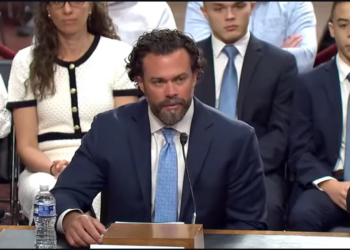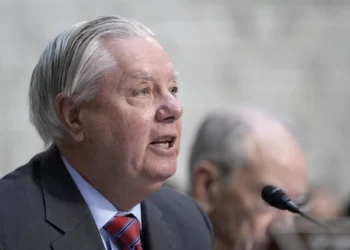The offshore wind industry cast doubt on any new projects starting construction in the next year, as the Trump administration has removed subsidies for and added restrictions on the renewable power source.
President Donald Trump harshly criticized the industry while visiting Scotland in late July, saying his administration would not allow a windmill to be built in the United States. As his public criticisms increase and various agencies have taken action to stifle growth, that promise appears likely to come true.
No new projects are expected beyond the five offshore wind farms that have already begun construction off the coasts of Virginia, New York, Massachusetts, Rhode Island, and Connecticut. These projects are expected to be completed by 2026 at the earliest and generate anywhere between 700 and more than 2,000 megawatts of carbon-free energy.
“The assumption is that the five projects that are currently under construction are the only projects that are going to qualify … for the current incentives,” Katharine Kollins, president of the Southeastern Wind Coalition, told the Washington Examiner.
Kollins blamed recent restrictions imposed by the Trump administration on the federal permitting level, saying they will result in the number of wind projects able to start construction in the next year dropping to essentially zero.
“I don’t think that projects are under the assumption that there will be any major changes that allow them to then begin construction in the next 12 months,” Kollins said.
Congressional hurdles
The 12-month timeline is critical for new projects to claim some of the federal tax credits for wind power that are now set to phase out under the recently passed One Big Beautiful Bill Act.
The bill ends tax credits for wind and solar projects placed in service, meaning operational and plugged into the grid, after the end of 2027. There is a carve-out for projects that begin construction less than one year after the bill is enacted to claim the credit.
Offshore wind proponents have said several projects considered to be “shovel-ready” could meet that deadline, but they still must obtain a few crucial federal permits.
When the One Big Beautiful Bill Act was passed and signed in early July, many in the industry were still hopeful these projects could move forward.
‘There was sort of a next tranche of projects that effectively…have their costs, they have their record or decision, [and] they are very close to being able to start construction,” Hillary Bright, executive director of Turn Forward, told the Washington Examiner.
“[They] also could potentially start next year and fall under the truncated or changed timeline of the tax credits. And so I think there had been some thought that that was possible,” Bright continued.
Those hopes have since been shattered by the administration.
Trump’s restrictions
In the weeks following the bill’s signing, Trump issued a new executive order limiting which wind and solar projects can claim the tax credits. In the order, he called on the Treasury Department to issue guidance to ensure that projects cannot skirt the deadlines for phasing out the credits in the law.
The Department of the Interior has also taken substantial steps to limit offshore and onshore wind development, announcing that all agency-related decisions and actions related to wind and solar energy facilities must undergo strict “elevated” reviews by Interior Secretary Doug Burgum’s office.
This week, the agency took things a step further by launching four policy measures aimed at ending “special treatment” for wind. These include reviewing all policies biased in favor of wind and solar energy, reviewing mortality rates for migratory birds associated with wind energy projects, and considering terminating “wind energy areas” for future development.
Just one day later, the Interior Department announced it would rescind all designated wind energy areas for offshore development on the U.S. outer continental shelf. These areas, more than 3.5 million acres worth, have allowed the federal government to hold offshore wind lease auctions in the Gulf of Mexico, which Trump renamed the Gulf of America, as well as off the coast of New England and the western U.S. coastline.
On Friday, Burgum announced yet another order reining in future wind and solar projects, ordering the department to only permit “energy projects that are the most appropriate use of the federal land and resources.”
This will require the Interior Department to reconsider all possible alternatives for proposed renewable energy projects, as it relates to land use or area offshore, and determine the best possible use for the land when issuing permitting decisions.
“Thus, when there are reasonable project alternatives that can generate the same amount of or more energy on far less federal lands, wind and solar projects may unnecessarily and unduly degrade federal lands,” the agency said.
Bright told the Washington Examiner that it has become much clearer to the industry that the administration is intentionally lengthening the permitting pipeline for wind and all renewables.
Kollins said there is no firm green light for any of these projects to get shovels in the ground in the next 12 months or even the next 3 1/2 through the end of the Trump administration.
As a result, some of these developers are publicly warning of major delays or abandoning their projects entirely.
One of these nearly fully permitted projects, SouthCoast Wind in Rhode Island, said earlier this year that it plans to see delays as long as four years before it can start construction.
In June, Atlantic Shores Offshore Wind filed a petition to end its 1.5-gigawatt wind farm project off the coast of New Jersey.
“I think any project that, even if they technically have their permits, the thought of starting construction on something where one person in the federal government could stop that on a dime, that’s not an investment thing that I think most companies are willing to undertake,” Kollins said.
The five projects under construction also risk being halted by the government before they are completed.
In April, Burgum issued a stop-work order for the fully permitted Empire Wind project, saying the federal government rushed its approval. The project was ultimately paused for roughly one month, costing developer Equinor nearly a billion dollars.
Optimism on land
As offshore wind has faced the brunt of the administration’s ire, there are still opportunities for onshore wind development.
“While the permitting process for offshore wind may be paused, there are onshore projects that can and will continue construction,” Kollins said.
“I think because the onshore market is also so much more mature in the U.S., States understand the importance of the economic development benefits from onshore wind, the electricity benefits, and the near-term ability to generate more power when and where it’s needed,” she added.
She explained that, unlike offshore projects, not all onshore wind farms are subjected to an extensive federal permitting process. Additionally, these projects have garnered bipartisan support in Congress, including from staunch Republicans such as Sen. Chuck Grassley (R-IA).
Data compiled by the American Clean Power Association provided to the Washington Examiner reveals that nearly 30 wind projects nationwide could reasonably start construction in the next 12 months.
The industry group said these projects amount to roughly 5.6 gigawatts of total generation and would likely come online before 2028. This projection includes wind projects set to be built on both private and public lands, the latter of which would face more of the hurdles imposed by the Trump administration.
TRUMP’S OVERHAUL OF NUCLEAR REGULATORY COMMISSION SPURS FEARS OF MORE DELAYS
Wind advocates hope that their supporters in Congress will continue to push back on the administration’s actions against the industry, pointing to the need for the U.S. to utilize all types of energy to support soaring energy demands brought on by the artificial intelligence race.
“We really just keep kind of returning to all of the what direct benefits, and associated benefits of offshore wind that really aligned so well, also with many of [Trump’s] priorities, including shipbuilding …. as well as needing the electron to really compete in this AI dominance space that the United States is leaning into,” Bright said.
















